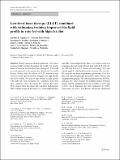Low-level laser therapy (LLLT) combined with swimming training improved the lipid profile in rats fed with high-fat diet
Author(s)
Sene-Fiorese, Marcela; Aquino, Antonio E.; Paolillo, Fernanda R.; Duarte, Fernanda O.; Oishi, Jorge C.; Pena, Airton A.; Duarte, Ana C. G. O.; Bagnato, Vanderlei S.; Parizotto, Nivaldo A.; Hamblin, Michael R.; ... Show more Show less
Download10103_2012_Article_1223.pdf (416.0Kb)
PUBLISHER_POLICY
Publisher Policy
Article is made available in accordance with the publisher's policy and may be subject to US copyright law. Please refer to the publisher's site for terms of use.
Terms of use
Metadata
Show full item recordAbstract
Obesity and associated dyslipidemia is the fastest growing health problem throughout the world. The combination of exercise and low-level laser therapy (LLLT) could be a new approach to the treatment of obesity and associated disease. In this work, the effects of LLLT associated with exercises on the lipid metabolism in regular and high-fat diet rats were verified. We used 64 rats divided in eight groups with eight rats each, designed: SC, sedentary chow diet; SCL, sedentary chow diet laser, TC, trained chow diet; TCL, trained chow diet laser; SH, sedentary high-fat diet; SHL, sedentary high-fat diet laser; TH, trained high-fat diet; and THL, trained high-fat diet laser. The exercise used was swimming during 8 weeks/90 min daily and LLLT (GA-Al-As, 830 nm) dose of 4.7 J/point and total energy 9.4 J per animal, applied to both gastrocnemius muscles after exercise. We analyzed biochemical parameters, percentage of fat, hepatic and muscular glycogen and relative mass of tissue, and weight percentage gain. The statistical test used was ANOVA, with post hoc Tukey–Kramer for multiple analysis between groups, and the significant level was p < 0.001, p < 0.01, and p < 0.05. LLLT decreased the total cholesterol (p < 0.05), triglycerides (p < 0.01), low-density lipoprotein cholesterol (p < 0.05), and relative mass of fat tissue (p < 0.05), suggesting increased metabolic activity and altered lipid pathways. The combination of exercise and LLLT increased the benefits of exercise alone. However, LLLT without exercise tended to increase body weight and fat content. LLLT may be a valuable addition to a regimen of diet and exercise for weight reduction and dyslipidemic control.
Date issued
2012-11Department
Massachusetts Institute of Technology. Institute for Medical Engineering & Science; Harvard University--MIT Division of Health Sciences and TechnologyJournal
Lasers in Medical Science
Publisher
Springer London
Citation
Aquino, Antonio E., Marcela Sene-Fiorese, Fernanda R. Paolillo, Fernanda O. Duarte, Jorge C. Oishi, Airton A. Pena, Ana C. G. O. Duarte, Michael R. Hamblin, Vanderlei S. Bagnato, and Nivaldo A. Parizotto. “Low-Level Laser Therapy (LLLT) Combined with Swimming Training Improved the Lipid Profile in Rats Fed with High-Fat Diet.” Lasers Med Sci 28, no. 5 (November 14, 2012): 1271–1280.
Version: Author's final manuscript
ISSN
0268-8921
1435-604X